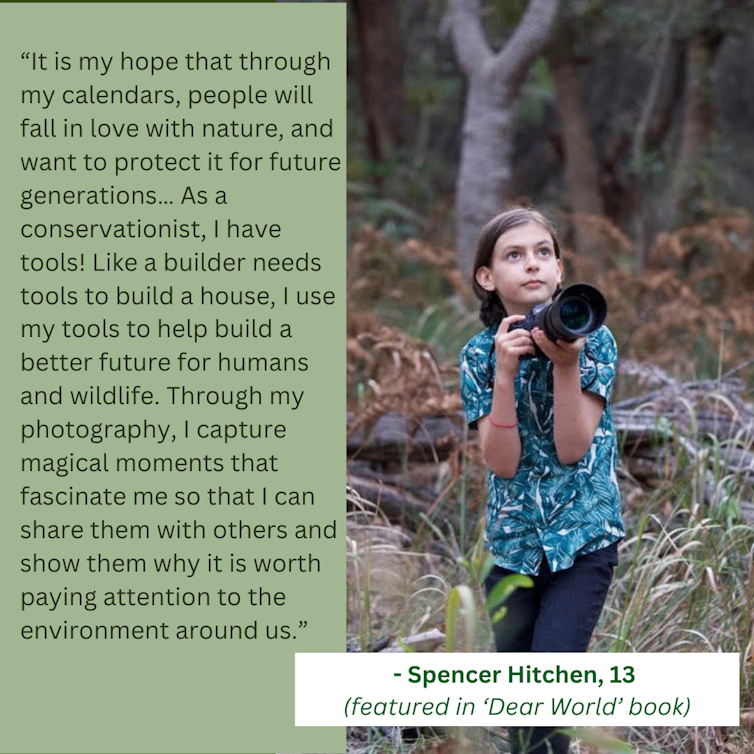Renowned scientist and conservationist Jane Goodall is touring Australia and New Zealand this week and next.
The 90-year-old “woman who redefined man” is best known for her discovery of tool-making in chimpanzees, our closest living relatives.
But I believe her impact on young people all over the world is even more profound.
For more than three decades, “Dr Jane” has inspired generations of conservationists through her youth-led action program Roots & Shoots. This successful self-directed project-based learning approach must be integrated into the school curriculum to support progress towards the United Nations’ Sustainable Development Goals.
The rise of ‘Roots & Shoots’
A global environmental education movement was born in 1991, when a group of 12 distressed teenagers gathered on Goodall’s front porch in Tanzania. The teens shared their concerns for the planet and explained they felt powerless to do anything about it.
Goodall listened. Together, they exchanged stories and ideas about potential solutions. The group left with a plan of action and “reasons for hope”.
More than 30 years later, Roots & Shoots is active in more than 60 countries.
Through Roots & Shoots, members select a cause they feel strongly about. Then they receive the tools, resources and support they need to develop and carry out their plan of action.
In this way, children as young as five can make a difference. Projects range from helping bring back local bird and bee populations, to reforesting derelict plots of urban land, or raising awareness of environmental issues through podcasts and videos.
Dear World – sharing success stories
Our new book, Dear World, is a collection of letters from environmental and social justice activists of all ages.
Both renowned and unsung activists share their personal stories and offer advice to others who want to create positive change.
For example, 13-year-old Spencer Hitchen of Noosa in Queensland was worried about the “Wallum ecosystem” of shrubs and grasslands in his “backyard” at Sunshine Beach.
He received a A$250 mini grant from Roots & Shoots Australia to help create a calendar featuring his photography, to raise awareness.

Other Roots & Shoots members are helping bring back local bee populations, raising awareness of “amazing animals” through educational videos, and offering earth-friendly lifestyle tips online.
It is the unstructured, informal nature of Roots & Shoots activities that make them so successful.
But there’s no reason why this model couldn’t work in the classroom. Students could be given the opportunity to conceptualise and implement their own environmental and social justice projects, applying their natural talents and interests to a cause of their choosing.
Expanding the Roots & Shoots model into formal education
As our research shows, there’s a strong evidence base for this. The free-choice project-based learning approach can be integrated into the curriculum on sustainable development. This would enable students to solve real-world environmental and social challenges.
The students could take part in a project for a single school term or a whole year, in the following way:
1) select a Sustainable Development Goal and topic of inquiry (such as a specific local environmental or social justice issue) of their choice, based on personal interest and curiosity
2) conduct self-directed research into potential solutions
3) tap into the expertise of local community leaders, Indigenous elders, older students, teachers and peers
4) implement the project and report back to the class about their impact
5) celebrate their success and learn from each other at a suitable forum, such as an open day or community exhibit.
Technology such as multimedia resources, online discussion forums and virtual field trips can also support the curriculum.
Step-by-step approach to implementing the Roots & Shoots program in the classroom

A lasting legacy
Young people will inherit the Earth. Their education must include developing skills to tackle the challenges they will surely face. This goes beyond learning about abstract concepts such as deforestation in the Amazon and climate change in Antarctica.
Nothing beats first-hand experience of developing and implementing practical solutions. Imagine the benefits of restoring a local ecosystem to witness the return of birdlife during the course of their schooling? Or making recycled toys for refuge dogs.
Last month we celebrated Goodall’s 90th birthday. I can’t think of a better way to honour her evolving legacy than to embed her Roots & Shoots model in our classrooms. It can be so much more than a nice-to-have extracurricular activity, enjoyed by a select few.
The author would like to acknowledge fellow Dear World co-editors, Nila Taylor and Benjamin Howes, and the 18 contributors who shared their stories for the book. Thanks also to Sakshi Srivastava for her comments on the draft of this article.

